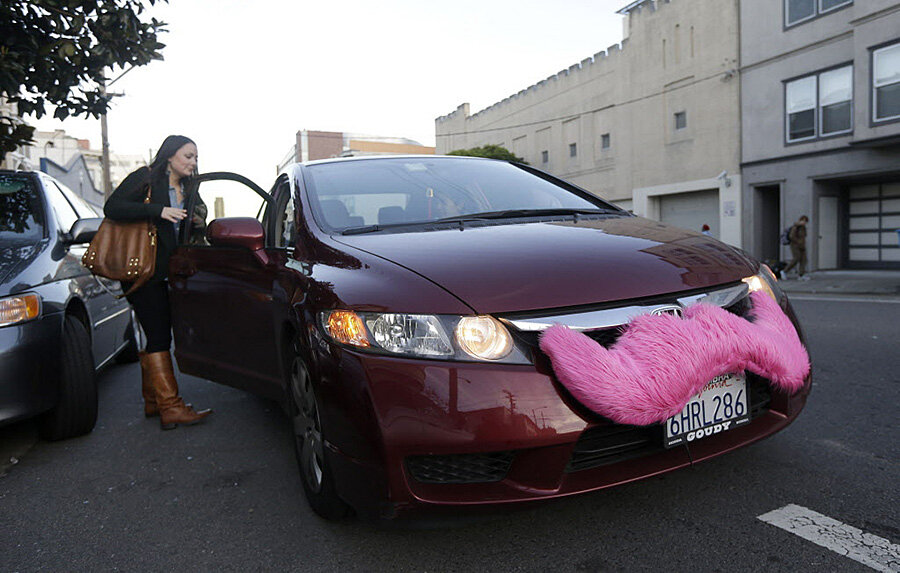Lyft president says car ownership will 'all but end' by 2025. Why so soon?
Loading...
The president of Lyft says self-driving vehicles will take over American roads much sooner than the auto industry forecasts. Within 10 years, to be exact.
“The car has actually become more like a $9,000 ball and chain that gets dragged through our daily life. Owning a car means monthly car payments, searching for parking, buying fuel, and dealing with repairs,” John Zimmer writes in a blog post published on Medium Sunday. “Every year, more and more people are concluding that it is simpler and more affordable to live without a car. And when networked autonomous vehicles come onto the scene, below the cost of car ownership, most city-dwellers will stop using a personal car altogether.”
In an interview with Time published the same day as the blog post, Mr. Zimmer said he expects car ownership to “all but end” across major US cities within 10 years. This timeline is much more ambitious than the one automakers have laid out, predicting most consumers will start to purchase autonomous vehicles by 2025. Zimmer, then, offers a new way of thinking about the transition to a driverless future: the self-driving revolution will start out simple, and grow in complexity. In other words, ride-hailers like Lyft and Uber will first offer short-distance rides to passengers. As technologies and regulations improve, those rides and networks will grow in complexity.
Zimmer’s comments come as a shift is underway among the transportation industry. Uber and Volvo have started the first beta tests in Pittsburgh, Pa. of semi-driverless taxis, with Google, Lyft and others announcing plans to follow. Public trials of self-driving buses are also being tested by the startup Local Motors in Washington D.C., and by EasyMile and Mercedes Benz in Finland and the Netherlands, Dubai, and Japan. Meanwhile, automakers are in a race to sell the first fully autonomous car. All of this, Zimmer argues, will soon transform cities, as privately owned cars sitting idle in parking lots and driveways will no longer dominate the landscape.
“We’ll have the chance to redesign our entire urban fabric. Cities of the future must be built around people, not vehicles. They should be defined by communities and connections, not pavement and parking spots,” he writes. “This urban re-imagination has the opportunity to deliver one of the most significant infrastructure shifts we have ever undertaken as a nation.”
Zimmer sees this shift playing out in two phases. The first will be over the next five years: most of Lyft’s fleet will become driverless. Lyft, the country’s second largest ride-hailer behind Uber, and General Motors (which announced in January it will invest $500 million in Lyft) have already began testing self-driving cars in San Francisco and Phoenix. They have promised their first rides to customers next year, according to Time.
“There are already specific trips – whether it’s just on this street or just at this time in this perfect weather condition – that an autonomous vehicle could do today,” Zimmer told Time.
As autonomous cars increase in popularity, writes Zimmer, consumers will opt to buy ride-hailing subscriptions for them instead of a new car of their own. Zimmer argues different subscriptions (like different cellphone plans) will enable users to customize the type of rides that best suits their destinations. As a bonus, users will save on individual car payments, fuel, maintenance, parking, and insurance.
Zimmer's announcements comes the week after Volvo and Uber grabbed headlines when they launched the public beta test of self-driving taxis in Pittsburgh.
Zimmer's vision also faces regulatory hurdles that could slow a majority of Lyft's fleet from becoming self-driving. While Zimmer told Time regulations will adjust to advances in the technology, present regulations require features that imply a driver must be able to take control of a vehicle. The National Traffic Safety Administration (NHTSA) released a study in May that found regulations would require self-driving cars be equipped with steering wheels, brake pedals, and other devices for humans to take control. Who, then, would grab the wheel or step on the brakes in an emergency? A human supervisor, or a passenger?
Still, Zimmer’s post adds to different ways of conceiving of a driverless future. Zimmer predicts the decline of parking lots and driveways that will open up vistas of space for housing, recreation, and greenery. Others predict the efficiency of self-driving vehicles will even reduce the size of roads and the speed of traffic.
"The highways of the future will be filled to the brim with cars traveling 3 to 4 feet apart from one another while going 60 to 70 mph, passengers kicking back and doing whatever it is they want to do," writes Newsweek's Erin Biba in January. "This will significantly increase the capacity of roads, and the number of cars that travel on them will skyrocket."
This future might also turn cities greener, as the use of parking lots disappear.
“I think we can just let our creativity run wild,” Carlo Ratti, director of MIT’s Senseable City Lab, told Ms. Biba.
Whether it's 10 years or 25, that future is a ways off. But the change to public transportation driverless cars can bring about is much nearer. Companies like EasyMile and Uber are already testing ways to combine ride-hailing vehicles to transit hubs to increase the efficiency of public transportation.
"For the first time in human history," writes Zimmer, "we have the tools to create a perfectly efficient transportation network."





